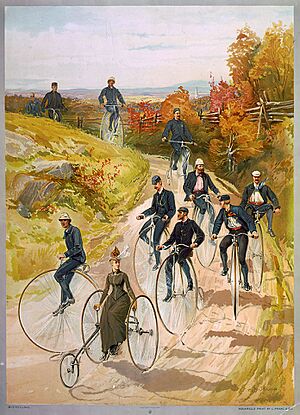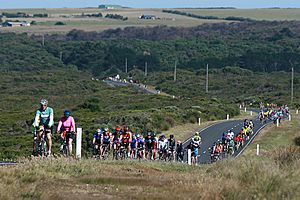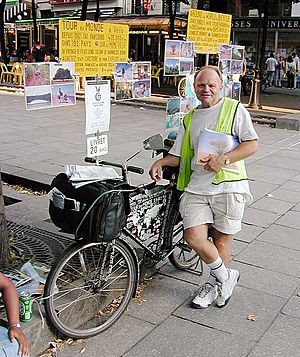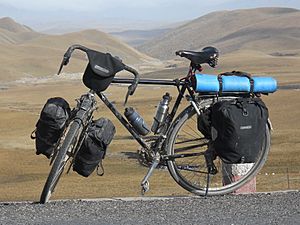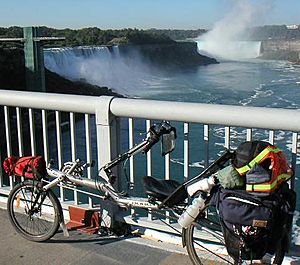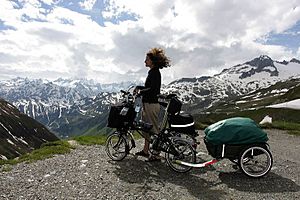Bicycle touring facts for kids
Bicycle touring is when you go on long bike trips, often carrying all your gear with you. It's about exploring for fun, adventure, or just to be independent. These trips can last from a single day to many weeks or even months. You can plan your own tour or join one organized by a company, club, or even a charity event.
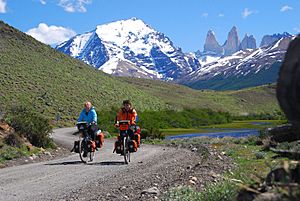
Contents
The Start of Bicycle Touring
Bicycle touring began a long time ago, even before bikes had pedals! In the 1800s, people rode "hobby-horses" (early bikes pushed by feet) and even raced them against horse-drawn coaches.
In 1869, three riders cycled from London to Brighton, a 53-mile trip, in 15 hours. Another group rode from Liverpool to London, which took three days. People were amazed by these "queer horses," calling them "whirligigs" or "valparaisons." Some even threw stones at the riders!
When pedals were added to bikes, it became much easier to travel longer distances. People started writing books about their bike adventures. For example, Joseph Pennell and Elizabeth Robins Pennell wrote about their tandem tricycle trip from Florence to Rome. Elizabeth might have been the first woman many Italians had ever seen riding a bike!
Around the World by Bike
Journeys became even more exciting. In 1884, Thomas Stevens rode a huge 50-inch bike around the world. He spent two years on the road, writing about his experiences. Then, in 1894, Annie Londonderry became the first woman to cycle around the globe.
In 1878, the Bicycle Touring Club was formed in Britain. It's the oldest national tourism organization for cyclists in the world! Members often wore special uniforms, like dark green jackets and knickerbockers. They even had buglers to signal directions during group rides.
This club inspired Paul de Vivie in France to start what became the world's largest cycling association, and he created the French word cyclo-tourisme. In the U.S., the League of American Wheelmen was founded in 1880. Today, Adventure Cycling Association is the main group for bike touring in the U.S.
Bikes and Society
At first, wealthy people enjoyed cycling, but soon, many ordinary people discovered the freedom it offered. Writers like H. G. Wells wrote about how bicycles changed the lives of people working in shops, allowing them to explore the countryside.

Wells described the amazing feeling of a first holiday morning, leaving behind the daily routine. He wrote about the fresh air and the joy of riding. For his character Hoopdriver, the bicycle literally and figuratively broke the boundaries of his world. He felt like a "bloomin' dook" (a duke) on his bike!
Bicycles also helped women gain more freedom. The "New Woman" in Wells's book wore "Rational Dress," which was more comfortable for cycling than traditional long skirts. This new clothing style, promoted by the Rational Dress Society, allowed women to cycle more easily and escape social limits. The bicycle truly changed manners and morals, giving people new ways to explore and connect with the world.
Modern Bicycle Touring
After World War II, many people started driving cars, and cycling became less popular in some places. However, between 1965 and 1975, the U.S. saw a "bike boom."
In 1976, to celebrate America's 200th birthday, a huge bike ride called Bikecentennial was organized. Thousands of people cycled from Oregon to Virginia. This event kick-started modern cycle touring in the U.S. and led to the creation of Adventure Cycling Association. This group has mapped routes all across America and Canada, with some rides taking up to three months!
In Britain, the Cyclists Touring Club grew to 70,000 members and continues to organize group tours. Since 1983, Sustrans has created the National Cycle Network, a system of long-distance bike routes on quiet roads and traffic-free paths.
Since 1980, many companies have started offering organized cycling holidays. Some provide lodging and route info for independent cyclists, while others offer guided tours with support vehicles that carry your gear. There are also charity rides where you raise money for a cause while cycling in exciting places. Websites like Warm Showers (started in 2005) help cycle tourists find free places to stay with local hosts around the world.
Bicycle touring is a big deal! In 2006, British cyclists spent £120 million on organized bike holidays. The Great Victorian Bike Ride in Australia brought in AU$2 million to local communities in 2011. Cycling is a great way to travel because it's inexpensive, healthy, and good for the environment.
Amazing Bike Journeys
Bicycle tours can be any distance or length. Some people ride for years! For example, Walter Stolle cycled through 159 countries in 18 years, starting in 1959. He paid for his trip by giving slide shows in seven languages. He was robbed 231 times and wore out six bicycles!
Heinz Stücke started his journey in 1962 and is still riding! By 2006, he had cycled over 539,000 kilometers (about 335,000 miles) and visited 192 countries. He sells photos to magazines to fund his travels.
Some people try to cycle around the world as fast as possible. The current record for cycling around the world is 78 days, 14 hours, and 40 minutes, set by Mark Beaumont.
Many famous writers have combined cycling with travel writing, like Dervla Murphy, who cycled from London to India in 1963 with just a revolver and a change of clothes! She said that cycling helps you connect with people and places better than other ways of traveling.
Types of Bicycle Touring
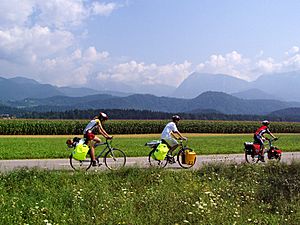
The distance you cover each day depends on your fitness and how many stops you make, but it's usually between 50 and 150 kilometers (30-90 miles). A short tour might be 200 kilometers (125 miles) over a few days, while a long tour could cross an entire country or even go around the world!
Here are some different types of bicycle touring:
- Lightweight touring: This is sometimes called "credit-card touring." You carry very little gear and stay in hotels or hostels, buying food along the way.
- Ultralight touring: You carry only the absolute essentials, but you are still self-sufficient.
- Fully loaded touring: Also known as "self-supported touring." You carry everything you need, including food, cooking gear, and a tent for camping.
- Expedition touring: This involves long trips, often through remote areas or developing countries. Your bike is packed with food, spare parts, tools, and camping gear so you can be completely self-sufficient.
- Mixed Terrain Cycle-Touring / Bikepacking: You ride on different types of surfaces, like paved roads and dirt trails, using a single bike. Bikepacking often means carrying minimal gear in special bags on your bike.
- Supported touring: A motor vehicle carries most of your equipment. This can be organized by a group of friends or by commercial holiday companies that provide guides, lodging, and luggage transfers.
- Day touring: These are single-day rides that can be short or long, with solo riders or large groups. They can be for fun, fitness, or to raise money for charity.
- S24O (Sub-24-hour Overnight): This is a short overnight trip. You ride to a campsite in the late afternoon, camp, and then ride home or to work the next morning. It's great for quick adventures!
Choosing a Touring Bike
For longer bike tours, you need a bike that can carry heavy loads comfortably. Special touring bikes are built for this. They often have a longer frame for stability, places to attach pannier bags (saddlebags for bikes) on the front and back, and wider tires for a smoother ride on different roads.
Some "ultralight tourers" prefer road bicycles or "Audax" bikes for speed. Since 2015, gravel bikes have become popular, combining speed with the ability to ride on unpaved roads.
Some cyclists use recumbent bikes, which you pedal while leaning back, for comfort. To carry even more gear, or to take weight off the bike itself, touring cyclists might use bicycle trailers. If you're on a "supported" tour, you don't need to carry much, so you can use a wider range of bikes depending on the terrain.
Finding Your Way
There are many navigation apps and websites that can help you plan your bike tour. Sometimes, GPS routes might lead to a dead end, but most bicycle tourers just go back and try a different path.
Famous Bicycle Tourists
Bicycle Touring in Stories
Here are some fictional stories that feature bicycle tours:
- The Bike Tour Mystery (2002) by Carolyn Keene (a Nancy Drew book)
- The Wheels of Chance (1896) by H. G. Wells
See also
 In Spanish: Cicloturismo para niños
In Spanish: Cicloturismo para niños


